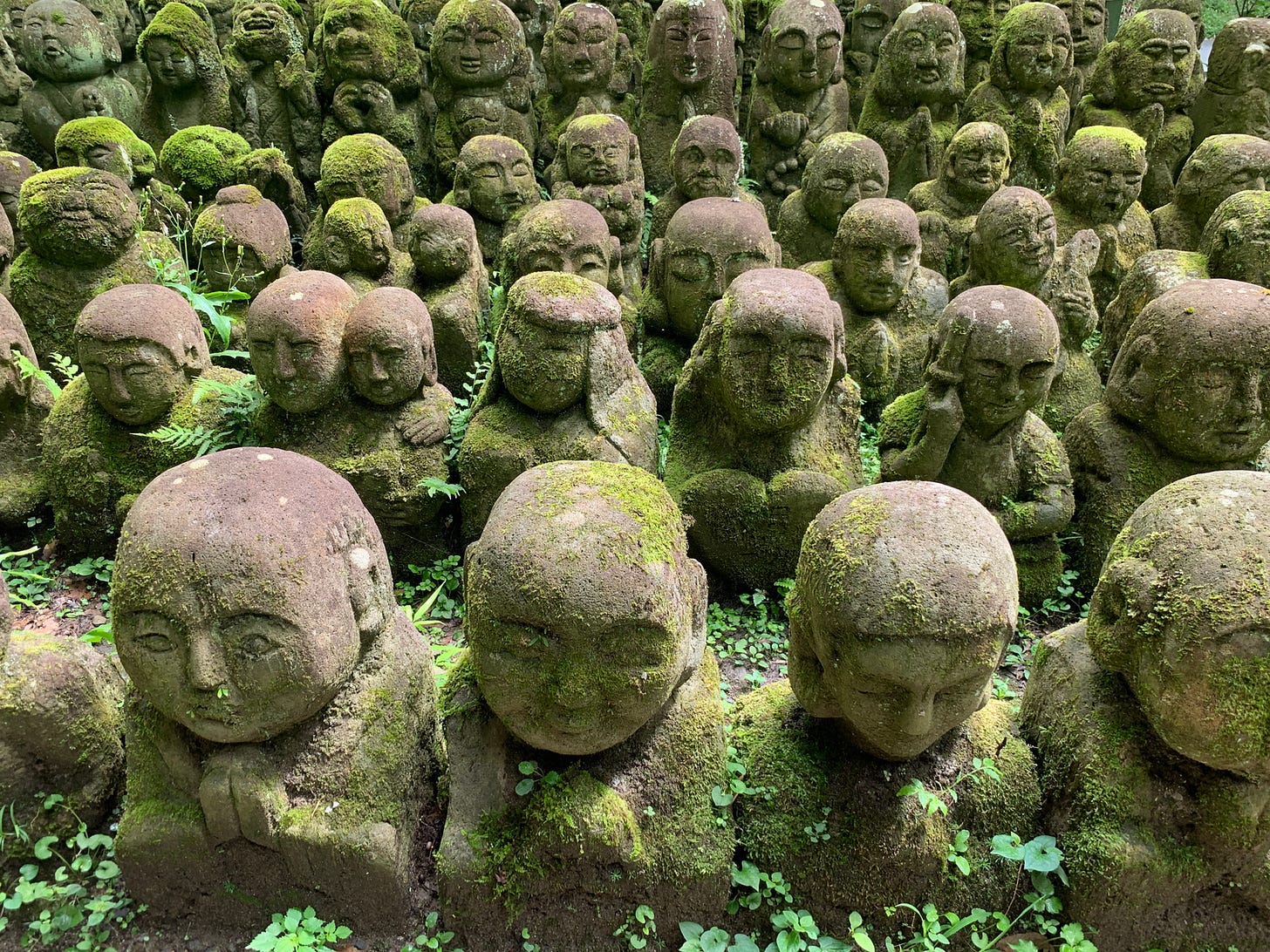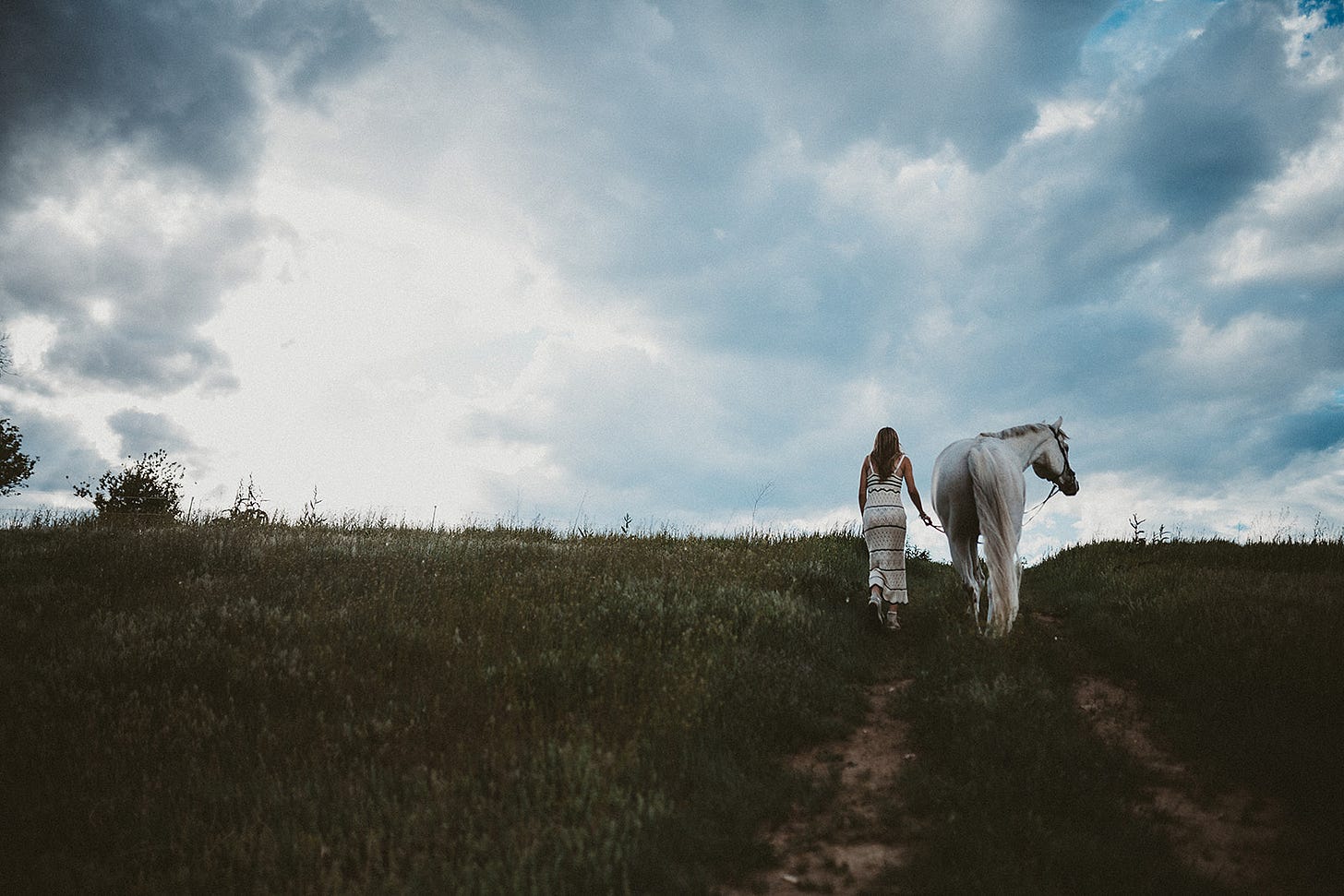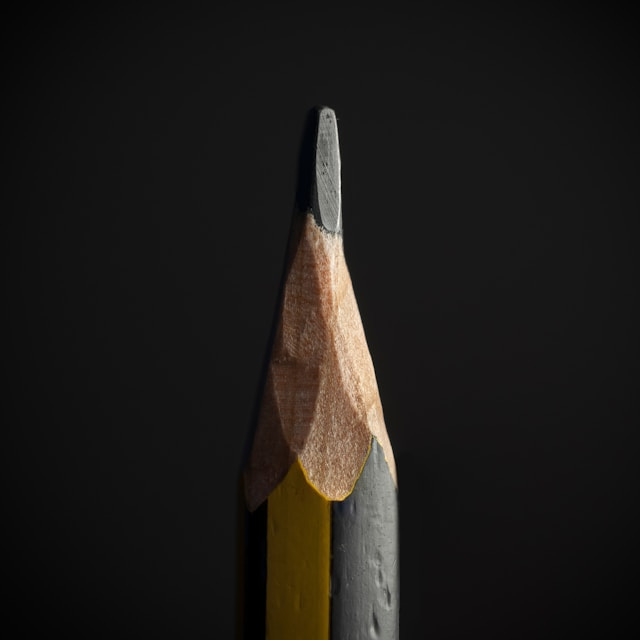Jorge Luis Borges returned again and again to the idea of mirrors. Sylvia Plath rewrote her own birth and re-birth across the length of a decade. Louise Glück admitted she was always writing the same poem, just getting closer to its truth.
Maybe we all are.
This column is about that quiet return. The repeated gesture. The poem we keep writing because it keeps asking to be written. Not for lack of imagination, but because some obsessions don’t resolve—they deepen.
#Field Notes
Dear Writers,
There is a poem I keep writing. In fact, I wrote a whole book of them. I changed titles, moved its setting. Sometimes it hid behind metaphor, and other times, there it was, bare-chested on the page. Shameless! Each time, I knew I was finished with it, and then, in a moment of quiet or grief, it stirred in the notebook again.
What if writing the “same poem” isn’t redundancy, but excavation? What if it’s not failure or lack of creativity, but instead perseverance?
Take the rakan…
Rakan statues are stone representations of the Buddha’s enlightened disciples, called Arhats, honored in Buddhist tradition for preserving the teachings and embodying wisdom. The rakan statues often number many hundred in one garden or at one temple.
At first glance, the statues may appear uniform—same robes, same expressions—but on closer inspection, each has distinct facial features, gestures, or quirks.
Their gathering represents a spiritual community, or sangha, and reinforces the idea that enlightenment is not a solitary path, but made up of diverse expressions of spiritual insight.
Thus our poems, our obsessions. Diverse expressions of our attempt to reach full understanding.
We often speak of obsession as if it were a problem to solve, something to "get over." But what if obsession is actually the source of our deepest artistic clarity? A poet returns to an image not because they lack new ideas, but because the image has not yet been exhausted of meaning. Repetition, then, becomes a form of reverence, a gesture toward the mystery that still resists full articulation.
Like the rows of rakan in the garden, each one similar, each slightly varied, the poems we return to are never truly the same. Something shifts. The angle. The light. The voice that’s speaking. Perhaps the point isn’t to bring closure the image. Isn’t to move on. Rather it may be to sit with the insights and our deepening awareness.
“I write one poem. All my life I have written one poem. I don’t mean to say I write the same poem…but I do mean that there is one poem that I have been writing all along.”
Stanley Kunitz
Could it be that we write “the same poem” not out of redundancy, but out of necessity? That one poem alone cannot bear the full weight of a complicated truth? Like the many rakan statues, each offering a slightly different gesture, expression, or mood, our repeated poems may represent facets of a single emotional or spiritual reality.
Each time we write, we approach the moment from a new angle: a different season, voice, or distance. And while any single poem may be partial or unfinished, together they form something more whole.
In this way, the repetition becomes a kind of accumulation, a deliberate layering of attempts. The act of returning is not failure, but fidelity, a devotion to understanding, to honoring the thing that continues to call us. Just as the rakan form a community, a spiritual chorus rather than a solo voice, our poems in repetition might form a constellation. And in their totality, they create a gestalt, a meaning-rich presence that could not exist without the repetition, the echo, the return.
I’d love to hear what you think. Do your poems distill to one ubiquitous theme? How do you consider this obsession? Is there more than one way to come to understand the drive to tell the story? Do tell yours.
#Frame & Phrase
“Return As Ritual”
This week, let return be your teacher. Let the act of writing feel like walking a familiar path, footfall by footfall, word by word, watching what changes under different light.
Or, let the image guide your imagination. Let it be your inspiration to take you where you need to go. “You are where you need to be,” mentor, Christopher Bursk, would remind me. Often. Choice to do as you wish with the photo is always an option.
Write a poem about something you return to—again and again. This might be:
A relationship or place
A wound, wonder, or question
A ritual (daily, seasonal, sacred)
Let the poem trace not just the thing itself, but how the return feels. What draws you back? What has changed in you? What remains stubborn, or beautiful, or broken?
Optional
Let form echo the feeling. Try using a circular form—such as a pantoum, a villanelle, or simply a refrain that loops or evolves. Allow the repetition to carry emotional weight. Let the return deepen, not flatten, the meaning. Think of Dylan Thomas’ villanelle “Do not go gentle into that good night” (recording also available) and the palpable heft of the repeated lines. For more on how to write a villanelle. For more on how to write a pantoum.
Also, here is a quick reference guide to many of the Poetic Forms that Use Repetition.
#From the Desk
On Pens, Pencils, and the Ritual of Writing Tools
Writers are often particular about what they write with, not because a certain pen looks good (though admittedly, they do!), but because the act of writing is physical, sensory, and ritual-rich. A pen, a pencil, a certain notebook, they’re not just tools, but collaborators. Check out a few of our favorite authors’ obsessions:
Neil Gaiman: Gaiman is known for his love of fountain pens. He writes his first drafts by hand, using pens like the Lamy 2000, Pilot Custom 823, and Visconti. He once mentioned, “My current favorite is a Visconti because it has a magnet in the lid which goes clunk when I put the top on — I am easily satisfied.”
John Steinbeck: Steinbeck had a unique routine where he would sharpen 24 Blackwing pencils before writing for the day, using each until it became dull.
Vladimir Nabokov: Nabokov wrote in pencil on index cards, so he could rearrange his stories like constellations.
Agatha Christie: Christie preferred a fountain pen… and sometimes the bathtub.
Stephen King: King has mentioned using a Waterman Hémisphère Fountain Pen, especially during the period when he was recovering from an accident and found writing by hand therapeutic.
Whether you write in a leather-bound journal, on a phone note app, or with a $1 Bic, your choice of tool holds a kind of quiet magic. It’s not indulgence—it’s intimacy.
What’s your writing ritual? A certain pen? Morning light? Lined paper only? Feel free to share it in the comments. I'd love to know what you return to, again and again.
#Margin Notes
Here is an excellent opportunity for poets to gather and create. There are just two spots left for River Heron’s third fall retreat—Recharge: A Poet’s Retreat, happening October 12–15, 2025, in eastern Pennsylvania at Boyds Mills.
This 4-day respite is for writers who crave time, space, and quiet encouragement. It’s perfect for those who long to step outside routine and into a rhythm of reflection, craft, and connection.
The retreat group is limited to a small (twelve) gathering of writers and includes daily generative writing sessions, time to revise, one-on-one consults at a cozy, restorative setting by the woods and creeks of the Pocono Mountains foothills. So many extras include guided trail walks, happy hour, farm fresh to table meals, and (truly) a caring staff that makes it all happen.
We’d love to write with you.
Questions? riverheronretreat@gmail.com
I love that you’re here with me today and hope you will check in each Thursday. I’m all about community and sharing, and maybe I can drop a few inspiring tidbits along the way. Always, I’d love to hear what’s up in your corner of the poetry world. Share!
Write and thrive,
Robbin
Coming up in 10 poetry notebooks:
Are your poems too obedient? Then it’s time to rewild the lines! And, of course, you can expect musings, news, and prompts, including the every other week photo prompt.
Beginning July 3, 10 poetry notebooks will include two posts a month that are available to every subscriber, both paid and free. On alternate weeks, the full post of the longer newsletter including the multi-layered image prompt will be shared with paid subscribers only. In order to receive this newsletter, please consider a paid subscription to help support 10 poetry notebooks and its author’s work.






There's a sweet and painful pop song Missy Higgins sings called WHERE I STOOD. In it she laments the fact that she is obsessing and part of her knows she should let go, for all kinds of reasons. The lyric is something like, "I don't know who I am, who I am without you, but I should." When I find myself writing my same poem, again, I catch myself thinking, I'm not sure who I am as a poet if I'm not writing about that (same) irresistible connection that brought me to writing poetry in the first place --but I should. And when I write the poem that I think I should, . . . well, I'm sure you all know what that feels like and what happens when you write a poem you think you should. Write poems, have no regrets about the poems you write or don't write. The exploration, is the path. Thanks for this post, it gave me the inspiration to reclaim my muse without a second thought (doubt). From "Weeds" by Edna St. Vincent Millay: White with daisies, and red with Sorrel/ And empty, empty, under the sky --/ Life is a quest and love is a quarrel. Can't find another of her poems that isn't exactly that.
The image of Monet and his seasonal painting of haystacks came to mind. I have no writing ritual, using a pen in a notebook, a journal, or just typing into a computer. Fine article.